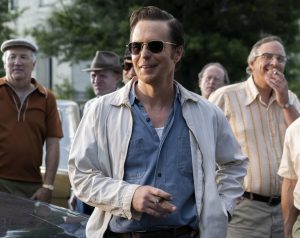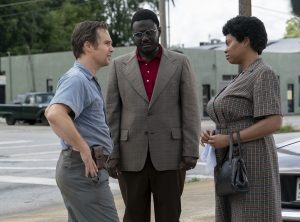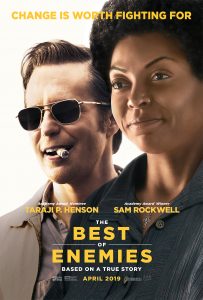‘The Best of Enemies’ chronicles the cause of change
“The Best of Enemies” (2019). Cast: Taraji P. Henson, Sam Rockwell, Babou Ceesay, Nick Searcy, Wes Bentley, Anne Heche, Bruce McGill, John Gallagher Jr., Nicholas Logan, Gilbert Glenn Brown, Caitlin Mehner, Mckenzie Applegate, Nadej Bailey, Kevin Iannucci, Charles A. Black, Dolan Wilson, Tim Ware, Ned Vaughn. Director: Robin Bissell. Screenplay: Robin Bissell. Book: Osha Gray Davidson, The Best of Enemies: Race and Redemption in the New South. Web site. Trailer.
Many of us dislike change, but sometimes it’s positively essential, no matter how much we may dread it. However, if we approach it with an open mind, a willingness to examine why we resist it and a spirit of cooperation to see the process through, making alterations and adjustments need not be as daunting as we believe it to be. Such was the case for a group of seemingly immovable citizens who wrestled with this question in the inspiring new fact-based drama, “The Best of Enemies.”
Even though 1971 might not seem like long ago to those of us of a certain age, it was very much a different time. This was especially true in some parts of the country and among particular constituencies, circumstances clearly reflected through their spokespeople.
Consider activist Ann Atwater (Taraji P. Henson). The feisty, highly passionate, always-outspoken community leader was someone not to be messed with. She never hesitated to make her opinion known, especially when it came to supporting the rights and well-being of her African-American constituents in the highly segregated city of Durham, North Carolina. She fought hard for her peers, sometimes even chastising her kindreds if they weren’t willing to work as hard as she did when it came to seeking justice and fair treatment.
Of course, Atwater wasn’t alone. The same approach she brought to the table could be said of C.P. Ellis (Sam Rockwell), the leader of the local Ku Klux Klan chapter. Ellis never tried to conceal his prejudicial attitudes, doing all he could to further the cause of segregation and promote the aims of White supremacists. Not only did he never hesitate to intimidate members of the Black community; he also took steps to bring his fellow Caucasians “into line” if they openly showed sympathy or support for minorities. He also had ample support for his efforts, such as the quiet backing of influential businesspeople and politicians, such as city councilman Carvie Oldham (Bruce McGill).

Community activist Ann Atwater (Taraji P. Henson, right) fights hard for her constituents in a segregated community in 1971 in the new fact-based drama, “The Best of Enemies.” Photo by Annette Brown, courtesy of STXfilms.
It’s hard to imagine two individuals who were more diametrically opposed to one another. So it’s almost impossible to fathom how they could have been drawn together to work out an issue they had in common.
The trigger for this unlikely collaboration was a fire at a predominantly African-American grade school. When the flames destroyed a substantial portion of the building, the students were displaced and in need of a new educational facility. Atwater and her followers supported a proposal to transfer the affected students to other, predominantly White schools while their structure was being rebuilt. But no sooner was the issue raised when it met with abundant vocal opposition from Ellis and his constituents. And, when the proposal was brought before the city council, it was summarily defeated.
However, when word of the proposal’s defeat reached the NAACP, the organization contacted Atwater, urging the filing of a lawsuit. The case ended up on the docket of Judge Leslie Hallford (Tim Ware), who wanted to do whatever he could to avoid having to try the case. After consulting Wilbur Hobby (Ned Vaughn), counsel to the court, the judge decided to pursue his attorney’s recommendation – calling for the formation of a charrette, an intensive, citizen-based planning session in which community members come together to work out a solution for the problem at hand, one that’s subsequently submitted to officials for review and possible ratification. Hobby then contacted Bill Riddick (Babou Ceesay), a facilitator experienced at organizing such programs, to see if he would be interested in conducting a charrette in Durham, an offer he quickly accepted.
Upon Riddick’s arrival in Durham, he assessed the situation and met with potential key players. The facilitator wanted chairpersons for the charrette who would be most representative of, and most zealous in advocating for, their respective communities. Given that this was a racially divided issue, he believed that meant finding suitable spokespersons for Black and White constituencies, namely, Atwater and Ellis.
Needless to say, the representative candidates were reluctant to even be in one another’s company, let alone work together. However, thanks to Riddick’s eminently convincing persuasiveness, he was able to bring the unlikely duo together to lead the charrette. Thus began a contentious yet transcendent process through which diehard combatants came together to reach resolution, a journey filled with tension, revelation and transformation.

C.P. Ellis (Sam Rockwell, center), leader of the local Ku Klux Klan chapter, does all he can to promote the cause of segregation in Durham, North Carolina in 1971 as seen in the new fact-based drama, “The Best of Enemies.” Photo by Annette Brown, courtesy of STXfilms.
Confronting the unknown can be a scary prospect, no matter how much we might try to put up a brave front. But, when the apprehension is stripped away, in nearly every case like this, the fear comes from a lack of knowledge, a failure or inability to understand what makes others different from us. This can create a major source of discomfort, one that often is perpetuated and strengthened through our beliefs. And those beliefs, in turn, make that discomfort into a reality, an outcome of the conscious creation process, the philosophy that maintains we draw upon these metaphysical building blocks to construct the existence we experience.
However, once we understand this, it should also be apparent to us that such manifestations are made – and are equally capable of being unmade, transformed into different configurations, including those that seem more familiar and don’t prompt the feelings of anxiety that can become cemented in our consciousness and, subsequently, in the reality before us.
Knowing that, then, we’re never locked into an intractable, unchangeable situation unless we specifically choose to be. Intentionally taking steps to learn about what distresses us can thus open us up to new possibilities, ideas we may have never previously considered due to belief blockages that have kept us from doing so.
This is precisely what happened among Blacks and Whites in Durham, especially in the lives of the two protagonists. Ellis came to see that the Black community was made up of human beings, in many ways just like the White community. And Atwater gradually realized that Ellis was not the devil incarnate, that her adversary had traits that made him just as human as those in her community. It took some time for these realizations to fall into place, but, by spending time working together and seeing one another up close, an understanding took root that subsequently changed the beliefs – and the reality – that each of Ellis and Atwater experienced.
This exercise in overcoming limitations and breaking down barriers is a primary objective of the conscious creation process. It’s reflective of its principal notion that we’re all in a constant state of becoming. What Riddick, Atwater and Ellis were able to achieve shows how radical change, no matter how outlandish it may initially seem, is indeed entirely possible, as long as we leave ourselves open to the possibility, something that begins with our beliefs.
For this to work, there are a number of other considerations that need to come into play. For instance, personal integrity is crucial, for it taps directly into the genuineness of one’s beliefs. If we’re to attain optimum results with our creations, we must make sure that we’re being scrupulously honest with ourselves when it comes to their underlying cornerstones. This became a critical issue for two White representatives of the charrette’s senate (John Gallagher Jr., Caitlin Mehner), the body of community members who actually voted on the citizen proposals put before them. They had to run their beliefs through their personal integrity filters when they were intimidated by Klan members and public officials who wanted them to vote down proposals favorable to the Black community. (Being true to oneself when it comes to balancing the needs of the public and those of the individual apparently can be challenging, especially when one’s personal safety and well-being are on the line.)

Community activist Ann Atwater (Taraji P. Henson, right) and Ku Klux Klan leader C.P. Ellis (Sam Rockwell, left) are brought together by facilitator Bill Riddick (Babou Ceesay, center) to resolve common issues in the new fact-based historical drama, “The Best of Enemies.” Photo by Annette Brown, courtesy of STXfilms.
This is another instance where the importance of overcoming those aforementioned fears is paramount. If we allow our fear-based beliefs to hold sway, we’ll never make any progress, for they undercut any efforts we initiate to make change. Admittedly, this may be difficult, but it’s essential to avoid stagnation or widening conflict.
It’s interesting to note how the process of change can take on a life of its own once it starts to be implemented. For example, in this case, this process began with finding a school for the students displaced by the fire. But, once the charrette participants started examining the students’ circumstances, they discovered there were more problems than finding a new place for them to attend classes. They learned that the students in the Black school were lagging behind their White counterparts due to such problems as using outdated textbooks and following inadequate curricula. Once revealed, these issues became fodder for other shortcomings to be addressed and corrected through the charrette’s deliberations.
This thus raises an intriguing question about why the fire may have happened: Was it simply due to some unforeseen combustible issue? Or was it a metaphorical catalyst to start the ball rolling where these issues were concerned? After all, would they have come up for discussion were it not for the fire that helped reveal and raise these matters in the first place? Indeed, had the fire not occurred, these problems may have persisted much longer without resolution.
Scenarios such as this often tend to extend to issues that go beyond simply what’s most at hand. They encourage us to dig deeper, to take more probing looks at what we’re creating and why, including the manifesting beliefs that underlie whatever results. This can be quite revelatory and transformative, leading to all manner of previously unconceived possibilities, such as the fact that, as unlikely as it may seem, Atwater and Ellis became life-long friends in the wake of their charrette experience. Now that’s change.

Despite a general tendency toward following formula and overstaying its welcome, this tale about an improbable alliance that arises from worlds apart partners shares messages that we can’t seem to get enough of these days. The fine performances of Henson and Rockwell give life to a story that starts out small and swells to larger issues that we can all benefit from learning about. This is due in part to the picture’s refreshingly balanced screenplay, which doesn’t hesitate to show the negative side of a likable character and the positive side of one generally seen as despicable. Only by getting a closer look at such questions will we be able to get past the prejudices and associated beliefs that hinder our pursuit of new opportunities aimed at benefiting everyone.
A word of note is in order here with regard to what many critics have been saying about this film. Many have called it simplistic in its approach, condescendingly writing that it covers trite, stale territory that’s been examined many times before and that we should all know by now. In doing so, they have unfairly bashed this offering in much the same way they did with recent Oscar winner “Green Book” (2018). And, quite frankly, I find such patronizing responses appalling.
As indicated above, there are aspects of this film that could have been handled better. On balance, though, this picture, like “Green Book,” is competently made and makes its case sincerely without becoming schmaltzy, simplistic or dogmatic. Those who have said otherwise are certainly entitled to their opinion, but, when their comments are as unduly smug, cynical and snide as many of them have been, I have to wonder whether they’re trying to present legitimate film criticism or to show off how smarmy and supposedly sophisticated they and their writing are.
Meaningful change can indeed be hard to come by. It takes work, both in our actions and in the underlying beliefs that give rise to them. In an age where we’re still being tested on these fronts, we must remain mindful of the challenges that remain at hand, including those that many of us (erroneously) believe have disappeared. Fortunately, we have examples like those illustrated in this film to help show us the way. Those who think we can’t learn anything from the past are sorely mistaken, for, if it was possible to institute such broad reform at a time when circumstances were considerably more difficult than they are today, then what excuse do we have now?
Copyright © 2019, by Brent Marchant. All rights reserved.




Leave A Comment